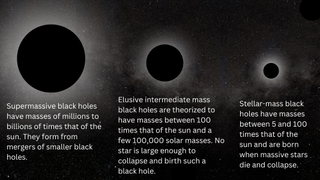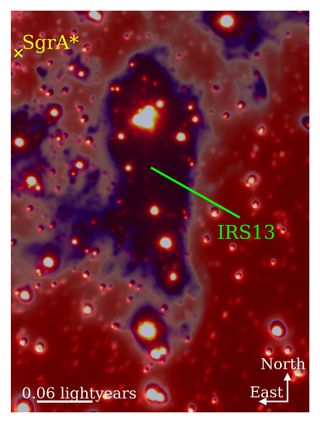For decades, astronomers have searched for traces of so-called “missing links” black holes, meaning black holes with masses somewhere between “stellar-mass black holes” and “supermassive black holes,” without much success. The former have been observed scattered throughout the universe, while the latter are cosmic titans that dominate the hearts of galaxies. But when it comes to intermediate-mass black holes, scientists have observed only about a dozen traces of these black holes.
As reported earlier this month, scientists announced that data from the Hubble Space Telescope has revealed the best evidence yet for an intermediate-mass black hole in Omega Centauri, the remains of a galaxy cannibalized by the Milky Way. And it seems that the search for intermediate-mass black holes is a lot like waiting for a bus in London: you wait a century to find one, and then suddenly two!
Another team of researchers has discovered evidence of another medium-sized black hole, this time lurking near the supermassive black hole Sagittarius A* (Sgr A*) at the heart of the Milky Way, some 27,000 light-years from Earth.
The team, led by Florian Peißker of the University of Cologne, discovered the intermediate-mass black hole while studying the star cluster IRS 13, located about 0.1 light-years from Sgr A*.
Related: Over the past 25 years, black hole physicists have discovered the unimaginable
“IRS 13 appears to be a key building block for the growth of our central black hole Sgr A*,” Peißker said. “This fascinating star cluster has been surprising the scientific community ever since its discovery about 20 years ago. Initially, it was thought to be an unusually heavy star. With the high-resolution data, we can now confirm the composition of the building block with an intermediate-mass black hole at the center.”
In Search of the Missing Voids of the Universe
Stellar-mass black holes, which have masses between 5 and 100 solar masses, form from the collapse of stars with masses at least eight times our own. Supermassive black holes, on the other hand, must have a different origin, because no star could be massive enough to collapse and leave a remnant. millions or even billions times more massive than the sun.
This information has led scientists to hypothesize that supermassive black holes must be born from the merger of chains of increasingly larger black holes. It is also thought that these cosmic titans grow by greedily feeding on the matter around them, including any unlucky stars that get too close and are torn apart and buried in the black hole in a so-called “tidal disruption event,” or “TDE.”
This means that there should be a population of black hole “seeds” in the cosmos that lie in that vast mass gap between stellar-mass black holes and supermassive black holes that have not yet reached “supermassive status” but are still too massive to have formed from a collapsing star. Yet these intermediate-mass black holes are extremely difficult to spot.

Like all black holes, intermediate-mass black holes are bounded by a light-trapping “surface” called an event horizon. Because of this boundary between the observable universe and everything inside a black hole, not only is it impossible for a signal to travel from the inside of a black hole to the larger cosmos, it’s also impossible to “see” a black hole. Unless it’s destroying stars in bright EDTs or feeding on the matter around it, which would heat up and glow intensely.
However, intermediate-mass black holes have failed to grow to supermassive sizes because they are not surrounded by a wealth of matter to feed on, so they do not emit bright light into their surroundings, meaning they are virtually completely dark. So scientists have to use clever techniques to detect intermediate-mass black holes that are not feeding. For example, they look at the behavior of visible matter around black holes, such as stars, to see if they are affected by gravitational effects. If so, these effects could be transmitted by a nearby black hole.

While observing IRS 13, Peißker and his colleagues observed that the stars in this cluster at the heart of the Milky Way moved in an orderly pattern. This was surprising, because the team expected the stars to be arranged randomly.
This observation could have two explanations. Either IRS 13 interacts with Sgr A*, causing its stars to move in an orderly manner, or there is a strong gravitational influence in this cluster that keeps it well ordered.
Using instruments such as the Very Large Telescope (VLT), the Atacama Large Millimeter/submillimeter Array (ALMA), and the Chandra X-ray Space Telescope, scientists were able to determine that the well-ordered compact shape of IRS 13 could indeed be due to the presence of an intermediate-mass black hole located at the center of IRS 13.
This discovery is supported by X-rays observed by astronomers from the star cluster, which indicate that ionizing gas is spinning at speeds of several hundred thousand kilometers per hour. This hot ionized gas could be swirling around the mouth of this newly discovered intermediate-mass black hole.
Not only would this provide astronomers with another “missing” link to a black hole, but the results could also explain a lingering mystery surrounding IRS 13. The star cluster appeared to be much denser than other similar star clusters in our galaxy — but that would be expected if it hosts an intermediate-mass black hole.
The team now plans to continue this research by studying IRS 13 with the James Webb Space Telescope (JWST) and the Extremely Large Telescope (ELT), currently under construction atop Cerro Armazones in the Atacama Desert in northern Chile.
The team’s research was published July 18 in The Astrophysical Journal.